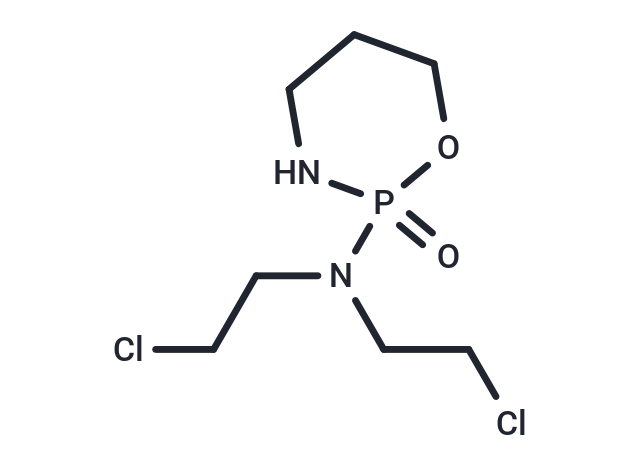Shopping Cart
Remove All Your shopping cart is currently empty
Your shopping cart is currently empty
Cyclophosphamide is an alkylating agent type of anti-tumor drug, and its main target is DNA. Cyclophosphamide inhibits the proliferation of tumor cells by undergoing alkylation reactions with DNA, interfering with the replication and transcription processes of DNA.

| Pack Size | Price | USA Warehouse | Global Warehouse | Quantity |
|---|---|---|---|---|
| 50 mg | $35 | In Stock | In Stock | |
| 100 mg | $51 | In Stock | In Stock | |
| 500 mg | $142 | In Stock | In Stock | |
| 1 g | $198 | In Stock | In Stock |
| Description | Cyclophosphamide is an alkylating agent type of anti-tumor drug, and its main target is DNA. Cyclophosphamide inhibits the proliferation of tumor cells by undergoing alkylation reactions with DNA, interfering with the replication and transcription processes of DNA. |
| Targets&IC50 | L1210 cells:> 300 μM, HL-60 cells:8.79 μM, HeLa cells:71.4 μM, DU-145 cells:52.5 μM, MDA-MB-231 cells:0.09 μM, PA-1 cells:64.12 μM, HEp-2 cells:> 100 μM, NCI-H522 cells:67.9 μM, K562 cells:0.153 μM, MCF-7 cells:0.16 μM, HepG2 cells:0.24 μM, COS-1 cells:125.43 μM, HCT15 cells:74.32 μM, T47D cells:69 μM |
| In vitro | METHODS: Human HL60 cells were treated with Cyclophosphamide, and cytotoxicity was detected by the MTT method. RESULTS: Cyclophosphamide inhibited the growth of HL60 cells, with an IC50 of 8.79 μM. [1] METHODS: Human K562 cells were treated with Cyclophosphamide for 48 hours, and the cell growth inhibition was detected by the MTT method. RESULTS: Cyclophosphamide inhibited the growth of K562 cells, with an IC50 of 0.153 μM. METHODS: Human MCF7 cells were treated with Cyclophosphamide for 48 hours, and cytotoxicity was detected using the SRB method. RESULTS: Cyclophosphamide inhibited the growth of K562 cells, with an IC50 of 10 mM. [2] METHODS: COS-1 cells and HCT-15 cells were treated with Cyclophosphamide for 24 hours, and cytotoxicity was detected by the MTT method. RESULTS: Cyclophosphamide inhibited the growth of COS-1 cells (IC50=125.43 μM) and HCT-15 cells (IC50=74.32 μM). [3] METHODS: DU-145 cells were treated with Cyclophosphamide, and cytotoxicity was detected by the MTT method. RESULTS: Cyclophosphamide inhibited DU-145 cells (IC50=52.5 μM). [4] METHODS: HCT-15 cells and HEK-293T cells were treated with Cyclophosphamide for 24 hours, and the cell growth inhibition was detected by the MTT method. RESULTS: Cyclophosphamide inhibited the growth of COS-1 cells (IC50=76.32 μM) and did not inhibit the growth of HEK-293T cells (IC5> 100 μM). [5] |
| In vivo | METHODS: Cyclophosphamide induces ovarian insufficiency (POI) by activating primordial follicles. Cyclophosphamide (150 mg/kg; Intraperitoneal injection A single dose was injected into 5-week-old female Balb/C mice. RESULTS: The number of primary follicles in the ovaries decreases. [6] METHODS: Cyclophosphamide induces bone marrow suppression by interfering with the proliferation and differentiation of bone marrow (BM) cells. Cyclophosphamide (150 mg/kg; Intraperitoneal injection A single dose was injected into 56-week-old male Swiss mice. RESULTS: It causes significant changes in the structure of bone marrow tissue, reduces the bone marrow/red blood cell ratio, and decreases the number of white blood cells in the blood. [7] |
| Molecular Weight | 261.09 |
| Formula | C7H15Cl2N2O2P |
| Cas No. | 50-18-0 |
| Smiles | ClCCN(CCCl)P1(=O)NCCCO1 |
| Relative Density. | 1.33 g/cm3 (Predicted) |
| Color | White |
| Appearance | Solid |
| Storage | store at low temperature,keep away from direct sunlight,keep away from moisture | Powder: -20°C for 3 years | Shipping with blue ice/Shipping at ambient temperature. | ||||||||||||||||||||||||||||||||||||||||
| Solubility Information | H2O: 20 mg/mL (76.6 mM), Sonication is recommended. DMSO: 255 mg/mL (976.67 mM), The compound is unstable in solution, please use soon. | ||||||||||||||||||||||||||||||||||||||||
| In Vivo Formulation | Saline: 20 mg/mL (76.6 mM), Sonication is recommended. 10% DMSO+40% PEG300+5% Tween 80+45% Saline: 5 mg/mL (19.15 mM), Sonication is recommended. Please add the solvents sequentially, clarifying the solution as much as possible before adding the next one. Dissolve by heating and/or sonication if necessary. Working solution is recommended to be prepared and used immediately. The formulation provided above is for reference purposes only. In vivo formulations may vary and should be modified based on specific experimental conditions. | ||||||||||||||||||||||||||||||||||||||||
Solution Preparation Table | |||||||||||||||||||||||||||||||||||||||||
H2O/DMSO
DMSO
| |||||||||||||||||||||||||||||||||||||||||
| Size | Quantity | Unit Price | Amount | Operation |
|---|

Copyright © 2015-2025 TargetMol Chemicals Inc. All Rights Reserved.